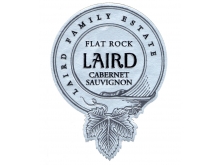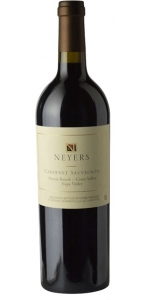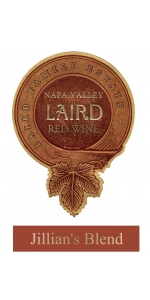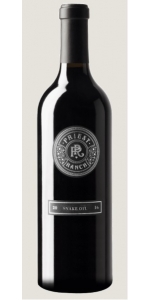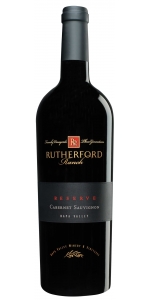Laird Cabernet Sauvignon Flat Rock Ranch 2013
| Country: | United States |
| Regions: | California California (Napa) |
| Winery: | Laird |
| Grape Type: | Cabernet Sauvignon |
| Organic: | Yes |
| Vintage: | 2013 |
| Bottle Size: | 750 ml |
Laird Cabernet Sauvignon Flat Rock Ranch is made from 100 percent Cabernet Sauvignon.
Laird's Flat Rock Ranch vineyard is located near the north corner of where Yountville Cross Road meets Silverado Trail, on State Lane. This prized, complex fruit from the Yountville Appellation is a result of unique geological and meteorological conditions: volcanic soils similar to the adjacent Stags Leap District, but also display ancient coastal deposits, and sedimentary and alluvial soils that provide beneficial stress for our vines. Marine air currents from San Pablo Bay to the south are caught when they reach the "Yountville Mounts," providing a natural cooling effect that balances warm, sunny days that ripen the rich tannins of our hallmark Cabernet Sauvignon to elegant distinction.
Bold violet-red color introduces a captivating bouquet of blueberries, tea leaf, and vanilla. This full-bodied wine has flavors of cassis, hazelnut and briary undertones with fresh acidity and chewy tannins on the palate
Review:
"The 2018 Cabernet Sauvignon Flat Rock is laced with crème de cassis, menthol, lavender, spice and blueberry jam. Inky and plush, the 2018 also has quite a bit of energy backing it all up. The 2018 is a gorgeous wine from Laird.- Antonio GALLONI"
- Vinous (The 2019 Napa Valley Cabernets: A Deep Dive, January 2022), 93+ pts
Neyers Cabernet Sauvignon Neyers Ranch is made from 100 percent Cabernet Sauvignon.
"We harvested the 2017 Cabernet Sauvignon crop from our Conn Valley Ranch in the first week of October, a week later than we picked the same vineyard the prior year. The size of the crop was about 20% smaller in 2017 as well, mostly due to the cold, wet weather we experienced in spring during flowering. Grapevines are self-pollinating, and cold, windy or damp weather interferes with this process, a problem known the French call coulure. Ironically, the harsh spring weather of 2017 had a huge impact on the size of our crop. Still, this smaller crop ripened fully and evenly, and at harvest time we picked beautiful, dark-colored clusters under near-perfect conditions. The finished wine was immediately remarkable for its flavor and complexity, and the wine looks to be one that will improve for many years. During my career in the Napa Valley wine business, I’ve learned to expect the best wines from cold years like 2017. These are vintages that are viewed initially with lowered expectations, but my experience has been just the opposite. Going back to my first Napa Valley harvest in 1971, these ‘colder years’ invariably result in wines with brighter, more attractive flavors, and the wines age longer and more gracefully.
Following harvest, the wine was fermented using wild, native yeast in an temperature-controlled stainless steel tank. After 45 days or so, the tank was drained and the pomace pressed, and the wine transferred to 60-gallon French oak barrels, 25% of them new. During the first year, we racked the wine off of the yeast lees three times, and by May 2019 it had been sufficiently clarified to bottle without fining or filtration. I am especially impressed by its bright ruby hue, a color so commanding it reminded me of the 1995 red Bordeaux wines I tasted from barrel during my trip to France in the Spring of 1996. It’s loaded with flavors that range from wild cherry to chocolate, enhanced by the lovely hint of tobacco leaf and mint. Each aromatic component has its own individual fascination, but all of them together provide a remarkable experience. Here’s a complete Napa Valley Cabernet Sauvignon that we expect it to improve for 20 years. It's a from a very small crop that will provide decades of pleasure." - Bruce Neyers
Review:
Earthy, tannic and young, this wine brims in black fruit, cedar and tobacco that are accented by black olive and crushed rock. With substantial midpalate weight, it takes time to integrate, finding a cohesive conclusion on the long finish.
-Wine Enthusiast 92 Points
Laird Jillians Red Blend is made from 65% Cabernet Sauvignon, 18% Syrah, 10% Merlot, 5% Malbec and 2% Petit Verdot
21 months in 75% French Oak and 25% American Oak (40% new and 60% neutral)
Vineyard: Cabernet Sauvignon (60% Mast Ranch + 40% Linda Vista Ranch), Syrah (100% Eagle Vines Ranch), Merlot (100% Big Ranch), Malbec (100% Flat Rock Ranch) and Petit Verdot (100% Flat Rock Ranch).
Appellation: Napa Valley
Our family has been proudly growing grapes in Napa Valley for two generations; this unique fusion of four varietals honors the youngest member of the third generation in our farming family, our daughter Jillian. This Left Bank Bordeaux-style blend with a twist of Rhone is structured, but easy to drink. Jillian’s is the only blend we make and it’s our most popular red wine.
Tasting Notes: Complex and precocious just like the real Jillian. Its deep, ruby red appearance accompanied by viscous legs leads the way to a seductive bouquet of toasted oak, lavender and ripe strawberries. A medium bodied palate, with delicate tannins and acidity, leads the way to tart dusty cherries and boysenberries that dance across your palate, while flavors of clove, vanilla and blueberry custard unfold on the finish.
Laird Jillians Red Blend is made from 65% Cabernet Sauvignon, 18% Syrah, 10% Merlot, 5% Malbec and 2% Petit Verdot
21 months in 75% French Oak and 25% American Oak (40% new and 60% neutral)
Vineyard: Cabernet Sauvignon (60% Mast Ranch + 40% Linda Vista Ranch), Syrah (100% Eagle Vines Ranch), Merlot (100% Big Ranch), Malbec (100% Flat Rock Ranch) and Petit Verdot (100% Flat Rock Ranch).
Appellation: Napa Valley
Our family has been proudly growing grapes in Napa Valley for two generations; this unique fusion of four varietals honors the youngest member of the third generation in our farming family, our daughter Jillian. This Left Bank Bordeaux-style blend with a twist of Rhone is structured, but easy to drink. Jillian’s is the only blend we make and it’s our most popular red wine.
Tasting Notes: Complex and precocious just like the real Jillian. Its deep, ruby red appearance accompanied by viscous legs leads the way to a seductive bouquet of toasted oak, lavender and ripe strawberries. A medium bodied palate, with delicate tannins and acidity, leads the way to tart dusty cherries and boysenberries that dance across your palate, while flavors of clove, vanilla and blueberry custard unfold on the finish.
REVIEW
Deep garnet-purple in color, the 2018 Cabernet Sauvignon Snake Oil needs a little swirling to reveal emerging notes of freshly crushed blackcurrants, blackberry pie and mulberries plus suggestions of tilled soil, cedar chest and Indian spices with a touch of roses. The full-bodied palate completely coats the mouth with opulent black fruit preserves and exotic spice layers, supported by velvety tannins and lovely freshness, finishing long and perfumed.
-Wine Advocate 93+ Points
The 2018 Priest Ranch Snake Oil is all Cabernet Sauvignon, from a trio of hillside vineyards on the Somerston Estate. It has beautiful blueberry and plum fruits as well as notes of sappy herbs, violets, and bouquet garni. More medium-bodied, focused, and elegant, it shines for its purity, freshness, and length. It’s a classic 2018 that will have 15+ years of longevity.
-Jeb Dunnuck 93 Points
Our 2018 Snake Oil was handpicked, sorted, and fermented naturally, then aged for 24 months in 75% new French oak barrels and 25% once-used French oak barrels.
HARVEST NOTES
The early half of 2018 brought us moderate temperature allowing for a long growing season. We had a majority of our rainfall in February followed by a mild Spring. Then summer brought consistent temperatures with little heat spikes. This weather allowed for longer hang time and for the fruit to ripen at a slower rate. The 2018 harvest at our estate began in late August and resulted in exceptional quality.
Rutherford Ranch Reserve Cabernet Sauvignon
Rich and vibrant with classic Rutherford Cabernet tannins, dark cherry mingled with toasty oak, sweet oak and sweet sage lingering on the palate.
The base for our Reserve Cabernet is from the world-renowned Rutherford appellation, which is home to our Abela and Franklin estate vineyards. Perfect climatic conditions and the region’s deep, loamy, well-drained soils produce dark, intensely flavored Cabernet Sauvignon grapes. Our rich soil sets the foundation for an exquisite, cellar-ready wine that will evolve in character and quality for years to come.
This Reserve Cabernet Sauvignon is a beautiful complement to ribeye steak, rack of lamb or mushroom risotto.
Review:
A flint and gunpowder nose leads to bold graphite, blueberry and tobacco flavors in this full-bodied wine that is laced with a high level of fine-grained tannins. This wine is meant for aging, being so tightly packed with fruits and minerals and having the structure to keep it fresh while more complex flavors develop over time. Best from 2028–2038.
-Wine Enthusiast 93 Points
Laird Cabernet Sauvignon Flat Rock Ranch is made from 100 percent Cabernet Sauvignon.
Our Flat Rock Ranch vineyard is located near the north corner of where Yountville Cross Road meets Silverado Trail, on State Lane. This prized, complex fruit from the Yountville Appellation is a result of unique geological and meteorological conditions: volcanic soils similar to the adjacent Stags Leap District, but also display ancient coastal deposits, and sedimentary and alluvial soils that provide beneficial stress for our vines. Marine air currents from San Pablo Bay to the south are caught when they reach the “Yountville Mounts,” providing a natural cooling effect that balances warm, sunny days that ripen the rich tannins of our hallmark Cabernet Sauvignon to elegant distinction.
Tasting Notes: Bold violet-red color introduces a captivating bouquet of blueberries, tea leaf, and vanilla. This full-bodied wine has flavors of cassis, hazelnut and briary undertones with fresh acidity and chewy tannins on the palate.
Review:
"A focused and poised young cabernet with blackberry, blueberry and cherry aromas and flavors. Full body, velvety tannins and a long, flavorful finish. Shows depth and power. Better in 2019."
- James Suckling (December 2016), 93 pts
"The 2013 Cabernet Sauvignon Flat Rock Ranch, from another Yountville site, is softer than the Mast Ranch, with sweet tannin, dense purple color, plenty of crème de cassis, blackberry and blueberry. There is a nice floral element as well, and the wine finishes full, rich and impressive. Give it 3-4 years of cellaring and drink it over the following two decades."
- Robert Parker's Wine Advocate (Issue #222, December 2015), 94 pts
After nearly 50 years in the wine business, we understand the ins and outs of the industry, from the trends to the challenges. We believe that our success is due to our vineyard expertise as well as our shared goal to produce great estate wines.
With a concentration on Napa and Carneros vineyards, we have sought to produce wines that are “a window to a place.” Each one of our vineyards is different in expression, with its own subtle, yet distinctive character and voice. Each year renews in us an intense drive to understand, react to, and work with each vineyard to allow it to reach its full potential. This process, lead by our winemaking and vineyard management team, is crucial for the execution of successful wines.
With a concentration in Napa and Carneros vineyards, we have sought to produce wines that are “a window to a place.” Each one of our vineyards is different in expression: each has a subtle, yet distinctive vineyard voice. With every year there is an intense drive to understand, react to and work with each vineyard to reach its full potential. This process, lead by winemaker and vineyard manager, is crucial for the execution of successful wines.
While growing up to be a big city mechanical engineer in New York City, Ken held on to his family tradition of becoming a farmer. In 1970, Ken and his wife, Gail, purchased their first Napa Valley parcel. This neglected piece of land, adjacent to Tubbs Lane in Calistoga, held 70 acres of worn-down prune trees. With Prohibition forty years gone and Napa Valley positioned to re-emerge as viticulturally significant, Ken and Gail decided to develop the orchard into a grape vineyard. While knowing just short of nothing about viticulture, they were also $150,000 short to properly develop the orchard into a respectable vineyard. Picking up a tattered phone book, Ken went to the yellow pages and found eight listed wineries…Robert Mondavi being the only one he recognized.
With a phone call, Robert Mondavi himself agreed to walk the property. After they discussed soils, vines, yields, irrigation, and proper pruning, Robert agreed to finance a deal with the Lairds if they would plant 50% Gamay. The deal was struck with a resulting vineyard of 50% Gamay and 50% Cabernet Sauvignon. Mr. Mondavi guaranteeing the Laird’s Cabernet “to be the highest harvest price paid in the Valley.” The support and encouragement of Robert Mondavi would allow Ken to return to his passion: his family farming heritage.
By the late 1990’s the Laird vineyard holdings had exceeded 2,000 acres and the idea of making their own premium line of wines began to take shape. Architect, Jon Lail, showed Ken and Gail the plans for the iconic pyramid-shaped, multi-level winery. Construction began on what would become the Red Hen Ranch vineyard property north of Napa. Ken and Gail’s son, Justin, worked side-by-side with Ken in the vineyards and became the Vineyard Manger, while their daughter, Rebecca, became the General Manager of the winery. Rebecca’s daughter, Jillian, was born in 2005, the same year the winery’s first red blend was produced, appropriately named Jillian’s Blend (and it happens to be Laird Family Estate’s most popular wine). Justin’s daughter, Megan, works in finance in New York City. His son, David, is continuing the family’s farming legacy by working with his dad in the vineyards.
The vineyard holdings possess a cross section of geomorphic and microclimate idiosyncrasies that are poised to produce particular grape varieties that thrive in their desired terroir.
From the thick fog and marine winds in Carneros to the volcanic soils mixed with ancient coastal deposits in the lower bench of the Mayacamas Mountains, they farm their vineyards to produce fruit that best complements the hallmarks of the land.
- back
All older vintage wines have been purchased from a single collectors cellar. Pictures can be requested before shipment.
Bootleg Red Wine Napa County is made from 53% Petite Sirah, 41% Merlot, 4% Cabernet Sauvignon, 1.4% Cabernet Franc, 0.6% Petit Verdot.
The 2019 Bootleg blends Petite Sirah, Merlot, Cabernet Sauvignon blend from several appellations within Napa. The result is a dark red crimson color with aromas of raspberry, black cherry, barrel spice and tobacco and mocha. On the palate the wine is fruit forward with round structured tannins leading to a long finish.
Review:
Moving to a darker expression, the 2019 Bootleg Red Blend pours an inky black hue and offers up aromas of pencil shaving, boysenberry preserve, and sweet tobacco. Full-bodied, with full, ripe tannins, it reveals notes of preserved black plum, crushed purple flowers, and turned soil.
-Jeb Dunnuck 92 Points

